Tan Jumper–Jumping Spider Pencil Sketch p43 (Platycryptus undatus)
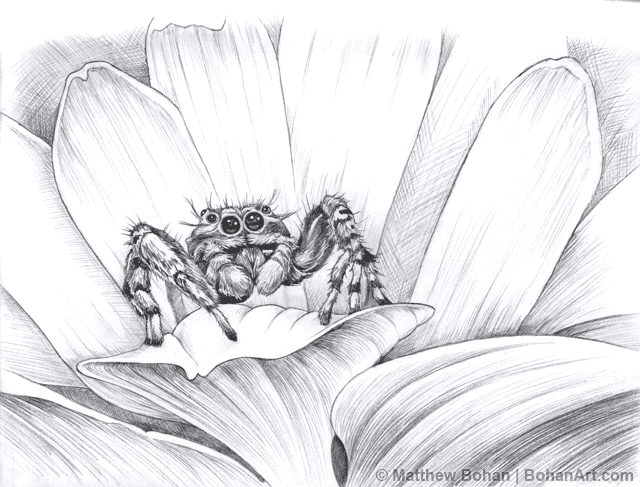
I realize that spiders aren’t everyone’s cup of tea. Some people get the creeps from these little guys.
I’m often asked how I decide what to draw and paint. In all honesty I just do whatever has my interest at the moment. Someone asked me recently if I run out of subjects to work on. I have more material to work on than time—probably too many. I have ideas that could keep me busy for the rest of my life.
For fun I almost always paint animals of some sort. Many times I’ve been asked if I do paintings of people. Sure, I can do them and have many times. I just don’t get much pleasure out of it. I joke that I’m drawing people all day long with medical illustration. I’m just doing one part at a time, or they just happen to be missing their skin!

Dimorphic Jumping Spider Pencil Sketch p42

One of the best things about homeschooling the kids is that we can have class outside on the picnic table when the weather cooperates. That improves everyone’s mood. I’m pretty open to “teachable moments” when a distraction is worthwhile. Springtime school supplies on the picnic table include three pairs of binoculars, so we’ve spotted a lot of good backyard and feeder birds during class.
Now Timmy and Kelly are really sharp, having learned long ago the art of distracting Daddy in the middle of class:
“Hey, Daddy, I hear a Carolina Wren! We haven’t seen one of those in a while…” 10 minutes of class gone
“Look, it’s our first female Common Redpoll this winter…” 12 minutes of class gone
“Get your camera Daddy, the Cooper’s Hawk is back…” 20 minutes of class gone
“Look, I think that is a Wilson’s Warbler!” 15 minutes of class gone
“Is that a Crossbill?!?!?” 18 minutes of class gone
I’m sure they can see the mental “brake lights” flash across my face every time they announce a great find. This summer I thought I’d streamline the distractions a little, so I brought out a few old film canisters to incarcerate the jumping spiders they kept finding on the picnic table. After our lessons I could photograph them and not interfere with class.
I shouldn’t imply that they are maliciously scheming to avoid schoolwork. They are great students, but they do welcome a change of pace at times. I suppose we all do. While attending St. John’s Elementary School, I remember getting caught watching the squirrels run along the power lines more than a few times. The kids share our passion for wildlife and have developed a great knowledge of the natural world around them. I’d argue that is a valuable education in and of itself.
The kids found this dimorphic jumper one afternoon. I brought it down to the basement to take photos in the light tent. I used a 100mm 2.8 macro with 68mm of extension tubes and a three-flash set up. Afterwards I released the cooperative little guy back where I found him.


Immature Grey Wall Jumper Pencil Sketch p41

I have mentioned that I get a lot of drawing done while waiting for my kids in karate. Many of the children come over and ask to see what you are drawing. They really seem to get kick out of it.
You never know what kids will say, but one thing is certain they are brutally honest.
Here are a few fun things I’ve heard over the years.
“Yeech!!!! Why would you want a picture of a snake?”
“Can you draw __________________?” (Fill in favorite cartoon character’s name here.)
“My __________ can draw better than that.” (Fill in child’s relative or friend here.)
“Will you draw a picture of a _____________ for me?” (Fill in child’s favorite animal here.)
“You could sell that.”
I’ve been drawing a lot of jumping spiders this year. When the kids see these I’m often “treated” to stories about how the they bravely killed some horriffic spider in their garden. After I mentally roll my eyes, I patiently will explain that here in Michigan there is virtually nothing to worry about. We only have two venomous spider species in the entire state. The likelyhood of running into them is almost statistically impossible. While there are a few like a marbled orb weaver that might bite it handled roughly, it wouldn’t be much worse than a bee sting. I’ll then point out all the benefits of spiders if they haven’t started snoring at my lecture.
One young boy told me quite a whopper about discovering an eight-foot wide and ten foot tall spider lurking in his room. I offered him many chances to bring the tall tale back to reality, but he kept digging himself in deeper. His story got progressively louder as he spun his own web. There was no doubt that he was enjoying everyone’s attention. Apparently the abundance of disbelieving looks had no inhibitory effect on the lad. On and on he retold of the fateful event….The Horrible Eyes…The Razor-sharp Fangs… The Dripping Venom… The Hairy Legs flailing with MALICIOUS INTENT…..Finally he got to the much anticipated climax, which included a hand-to hand clash with the eight-armed devil. He couldn’t resist going for the thrilling demise of the behemoth. In the heat of battle his mother killed the gargantuan arachnid….with a tissue. I said, “That must’ve been a BIG tissue to squash a ten foot tall spider!?!??! He didn’t even blink…”YUP, it was a big one.” To which his sister proclaimed, “You are such a lair!” I have the feeling she has heard quite a few! Maybe the boy’s future is in Hollywood. That will put his endless creativity to good use.
Magee Marsh Yellow Warbler Pencil Sketch p40
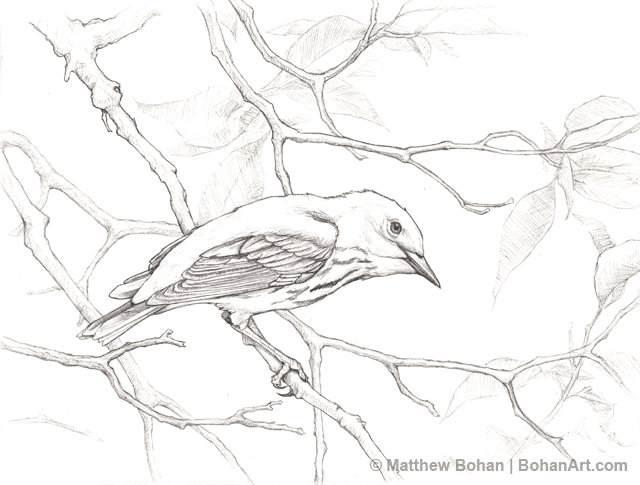
The Crane Creek, Ohio area is a favorite migrant hotspot in the Spring. Warblers are plentiful. We took our children for the first time this year. They had a blast and saw a handful of life birds. I brought along the 400mm lens to get some good photos for painting reference. This colorful male Yellow Warbler cooperated with the camera one day. The sketch should make for a fun painting down the road!
Halloween Bird Hats!


I have the coolest kids in the world. Every year they request an unusual costume. Inevitably it is some sort of animal. In the past requests have been bear, penguin, Red Fox, shark, Ruby-throated Hummingbird, Keel-billed Toucan, Tocu Toucan, Great Blue Heron, Great Egret, and a Barn Owl. I love the fact that they are nature lovers and want to be an animal on their “Big Day.” This does complicate things. While it is pretty easy to roll over to Target and pick up your Bat Man costume, finding the right bird costume tends to be a really tall order. Of course with the whole Angry Birds craze it might be possible to actually uncover a bird-related Halloween costume, but I only see the Angry Birds Cardinal and have never come across a Belted Kingfisher or Ivory-billed Woodpecker. Necessity being the mother of invention, meant I had to get creative and make some costumes.
I did once come across a great shark hat, which gave me the idea to build some bird hats. I was no stranger to making hats. While at the CIA….no not that one….I mean the Cleveland Institute of Art “CIA”, I had a design teacher who assigned a few hat projects. They included A Hat For Two where the students had to build a hat that could be worn by two people at the same time, and the Pingpong Ball Hat in which each person’s hat had to allow them to catch a ping pong ball AND pass it to the next in line while the class stood in a circle. To complicate matters the hats had to work no matter what order the students were lines up in. Those were complicated builds. At least these halloween costumes only function was to fit and look like the appropriate critters!
These hats are made from sheet craft foam, hot glue and acrylic paint.
More Backyard Jumping Spiders
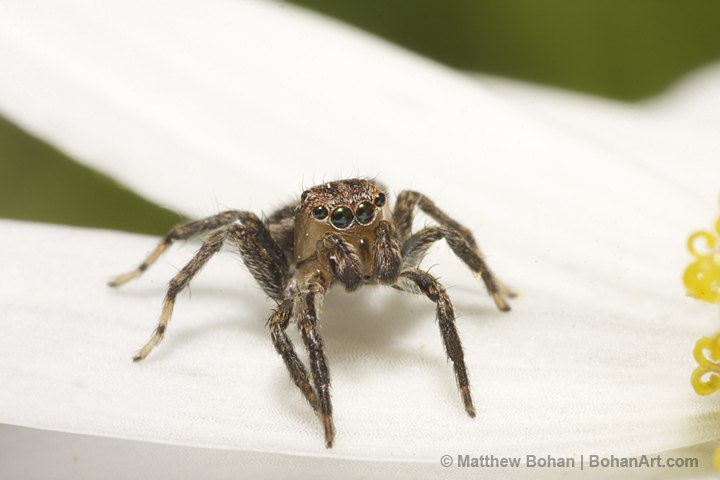
Canon 40d 100mm f2.8 Macro with 68mm extension tubes
Here are some more fun jumpers from the backyard. The jumping spider activity has really fallen off with the cool fall weather settling in. Once the first frosts come in I’ll be out of luck until spring. Included in these shots are an immature Gray Wall Jumper, a male Zebra Jumper (distinguished from the female of the species by its enormous fangs) and a Mustached Jumper.
I never took Latin or Greek in school, but I became interested in those languages when I was in college and grad school. At that point I was exposed to tons of anatomical terms, taxonomic classification and medical nomenclature and saw just how many Latin and Greek words we use. This group of spiders have some fun scientific names. The Zebra jumper’s proper name is Salticus scenicus. Salticus is Latin for “dancing/jumping”, while scenicus shares the same Greek root as scenic, meaning “decorative” or “flashy”. I’d say that is a great description of the spider! The genus of the Moustached Jumper/Tan Jumper is Platycryptus. Platy- means “flat”, while -cryptus translates to “hidden.” Finally, the Gray Wall Jumper’s scientific name is Menemerus bivittatus. Bivittatus is a fun and descriptive species name. Bi- of course means “two”, while -vittatus is “band or “stripe.” Unfortunately you don’t see much striping in the particular poses I took of this juvenile.

Canon 40d 100mm f2.8 Macro with 68mm extension tubes
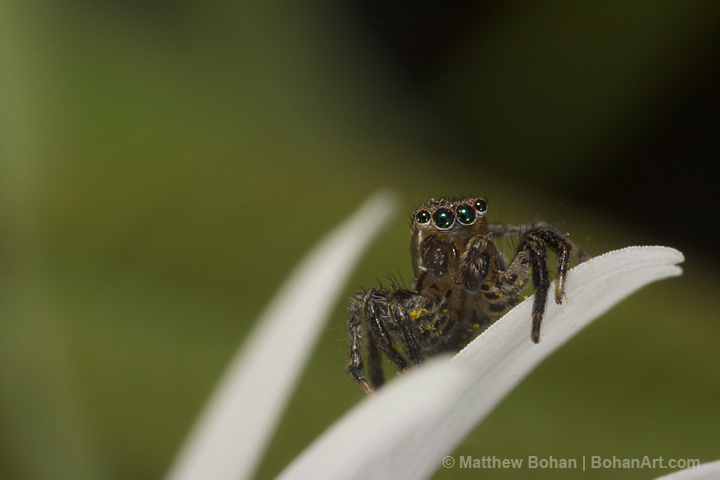
Canon 40d 100mm f2.8 Macro with 68mm extension tubes
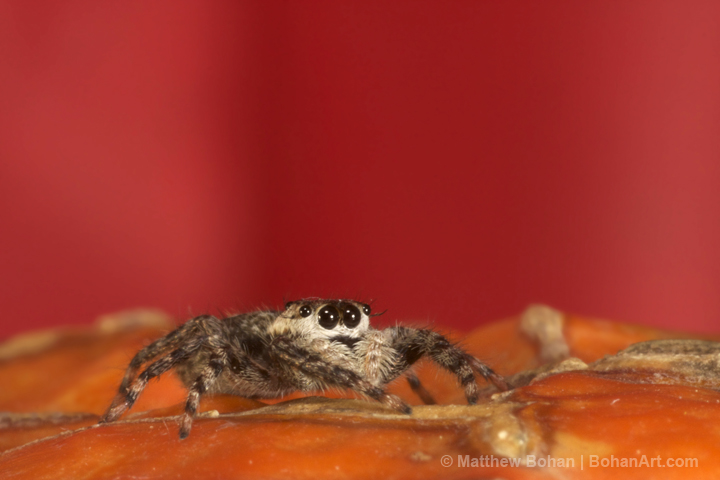
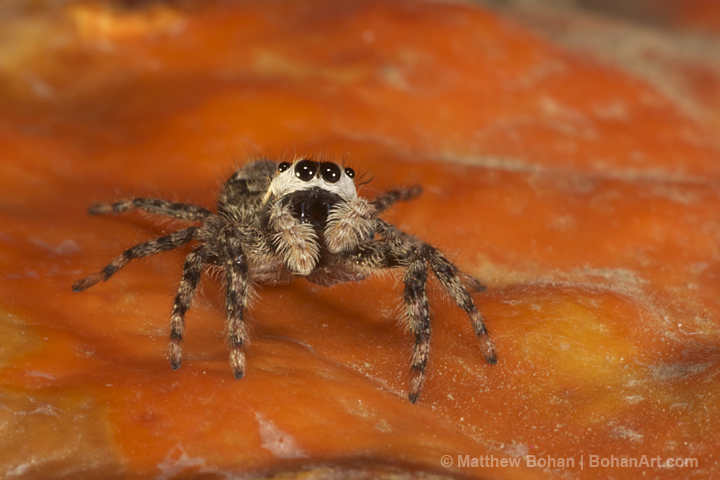
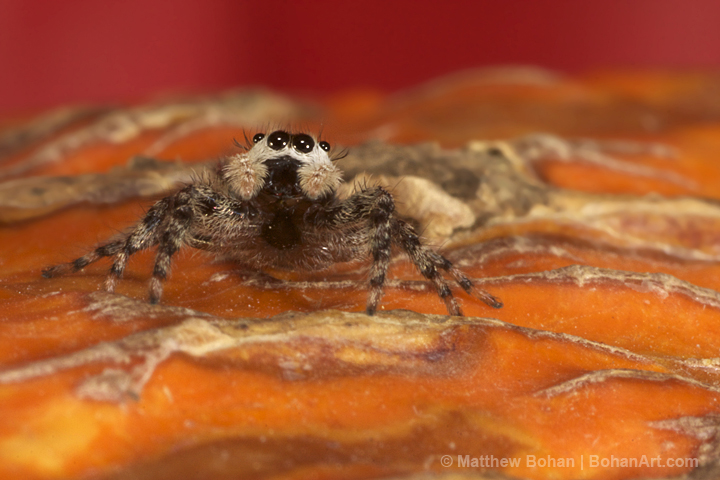


Canon 40d 100mm f2.8 Macro with 68mm extension tubes
Backyard Jumping Spider Photos

Canon 40d 100mm f2.8 Macro with 68mm extension tubes ISO 250
I know they aren’t for everyone, but I’m crazy about jumping spiders. I’ll photograph them every chance I get.
These small spiders are pretty easy to find. I often have good luck searching the side of the house. Jumping spiders love warm days and bright sunlight, and seem to completely disappear on cloudy rainy days. The jumping spiders belong on the family Salticidae, which comes from the Latin root word “Saltare” meaning “to jump.”
Taking shots of such tiny beasts can be tough. Jumpers move surprisingly quickly. In the macro world your depth of field is severely limited and you need a ton of light to get decent shots. Often I’m using extension tubes to cut the focusing distance down. This give a dramatic increase in magnification, but at the same time your depth of field plummets and you are forced to drown the spider in light from the several flashes so you have a good portion of it in focus.
Sometimes I do the photography outside in the garden. Even with all that natural light, I bring along at least two flashes to help even out the lighting and reduce the harsh shadows. Other times I gently collect the spiders and take them to the basement studio to photograph them in a big diffuser tent with a three flash set up and then release them after I get their photos.
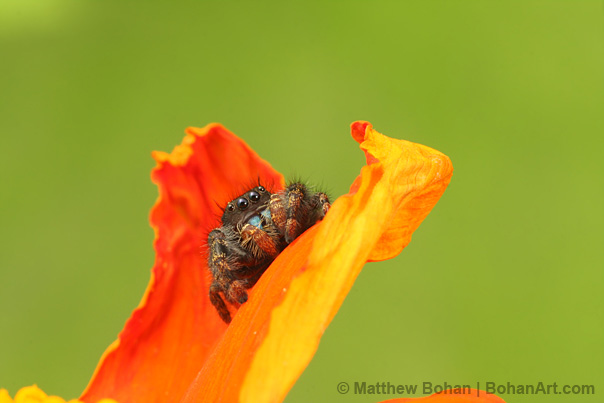
Canon 40d 100mm f2.8 Macro with 68mm extension tubes ISO 250

Canon 40d 100mm f2.8 Macro with 68mm extension tubes ISO 250

Canon 40d 100mm f2.8 Macro with 68mm extension tubes ISO 250
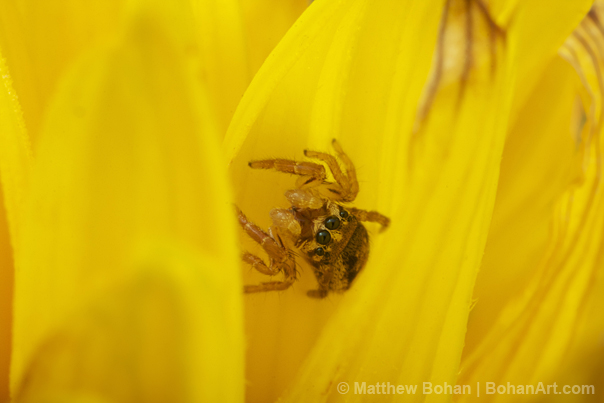
Canon 40d 100mm f2.8 Macro with 68mm extension tubes ISO 250

Canon 40d 100mm f2.8 Macro with 68mm extension tubes ISO 250
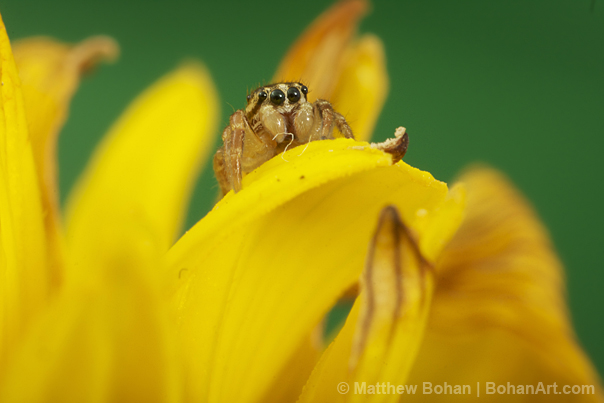
Canon 40d 100mm f2.8 Macro with 68mm extension tubes ISO 250
Toby Shepherd Chow Elkhound Tasmanian Devil Mixed Breed Pencil Sketch p38
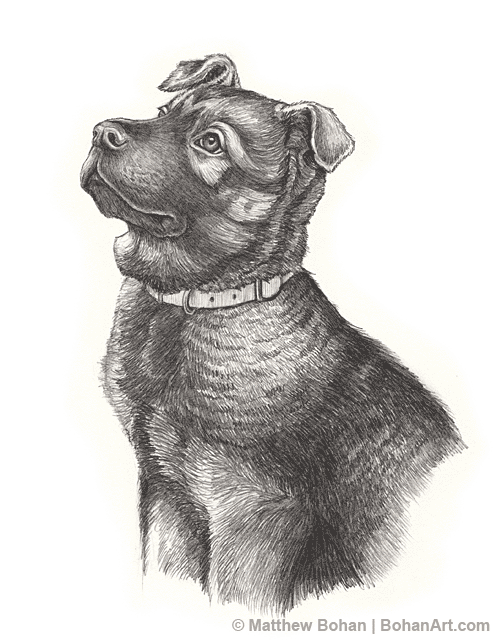

We call him “Toby the Terror” when he is the Devil Dog and “Toblerone” when he is sweet.
After the heartbreak of losing our perfect dog Archie days before Christmas, we got a new dog named Toby. He is about as unlike Archie as is possible. Archie was perhaps the most laid back and eager-to-please dog in history. He had almost no bad habits.
Toby is a very different dog. We got him as a puppy from the local Humane Society when he was only three months old. It has been great fun for the kids to watch him grow. While puppies are adorable and playful, living with a puppy is like having a member of the Taliban in your house. You can never predict when the next senseless terrorist attack will come. I’m confident that once he outgrows his youthful exuberance, he will be a great dog.
In the meantime he is full of surprises and challenges. He is determined to be in charge of the house. Since he outweighs our youngest, he doesn’t want to fall into the Omega role easily. We are in continual high alert, making sure he doesn’t completely rule the place. Toby has always been incredibly cute and now is becoming handsome. What he needs to do is spend more time on his personality. We will get there eventually!

In the meanwhile, here are Toby’s tips for other puppies:
When given the choice between dog toys and children’s toys, ALWAYS choose the human’s. This is most sensible. You not only get to chew up a new toy, you are virtually ensured a great game of chase in the process.
Squirt bottles, while highly annoying, are essentially harmless.
Humans place all edible objects on the floor. Don’t bother examining it, just eat it. The humans will then have the thrill of a treasure hunt in the back yard, finding the coins and springs that you have passed. It’s great fun for everyone!!!
Dogs clearly are in charge of this relationship. Let’s look at the facts. We destroy their toys and attack the children. In exchange for these services we are given food, housing, toys and free medical coverage. Further proof of this fact is simple… who is carrying the bag full of waste on the dog walk? Obviously the world revolves around us.
Every living thing wants to meet and adore you.
For some insane reason humans don’t want you to jump up on them or hug their legs. It is silly, so be persistent. If you can’t get away with a jump or hug, show them you care by giving them a big lick on the lips.
If it moves chase it. If you catch it, bite it.
Chair legs are surprisingly tasty. The same goes for cables and wires around the house. While you’re at it, don’t forget the steel cable you’re sometimes tied to outside. It is like a banana. Once you peel off the outer coating, there is another whole layer to chew on.
There are only two types on things in this world: Edible and Probably Edible. Don’t waste your time distinguishing them. Hesitate for a second and the silly humans might grab it out of your mouth. (Idiots!)
The world is not for the timid, so don’t be shy. Feel free to sniff anybody or anything anywhere you deem appropriate!
Brown-headed Nuthatch Pencil Sketch p36
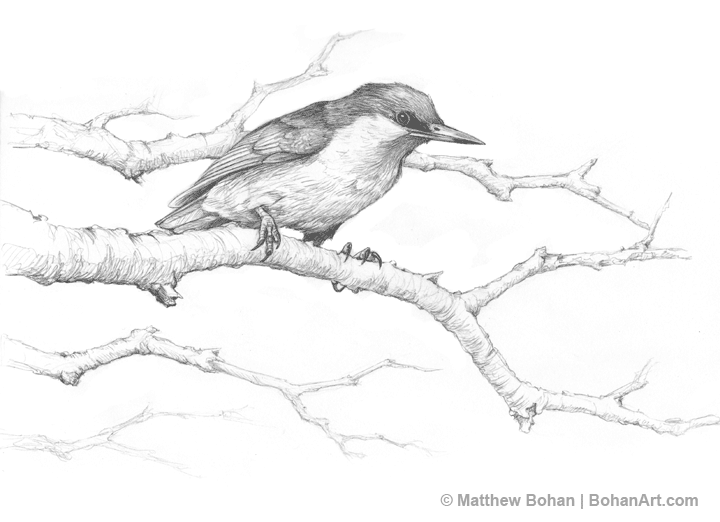
I have my brother-in-law to thank for this life bird. I haven’t spent much time in the South other than a few trips to the Florida Everglades, so I never got a chance to see a Brown-headed Nuthatch. My brother-in-law Erik has a bird feeder behind their house in central Tennessee. He and his family enjoy watching the birds come in and are becoming more and more familiar with the regular visitors.
Erik was stumped by one bird that was coming regularly and asked my mother-in-law Merritt what she thought it could be. Merritt is knowledgeable about all sorts of wildlife and produced a bird field guide for him to browse though. From his verbal description she thought it was a nuthatch.
Erik looked through the field guide and said, “It looks like this guy,” pointing to the Brown-headed Nuthatch. Though not impossible to locate in Tennessee, they are usually found among old pines in the hilly southern portion of the state near Chattanooga. They are rarely seen in middle Tennessee, but it turns out that there has been a small population living in the old pines surrounding the golf course near Erik’s house. Not a bad yard bird!
Knowing I’d be headed his way soon, I asked Erik how often he sees them, expecting to hear almost never. He said they usually visit the feeder every morning and sporadically throughout the day. Talk about spoiled. Sure enough, on our visit the Brown-headed Nuthatches showed up right on schedule. I was prepared with the 400mm lens, and I got some decent shots to draw from. What an easy was to get a lifer—while eating breakfast, with a cup of tea in one hand and binoculars in the other.
I was impressed with just how small and cute they are. The toy squeaker call they make only adds their appeal. Sadly, these little guys are hitting tough times and have dropped in population by almost half in the last fifty years.
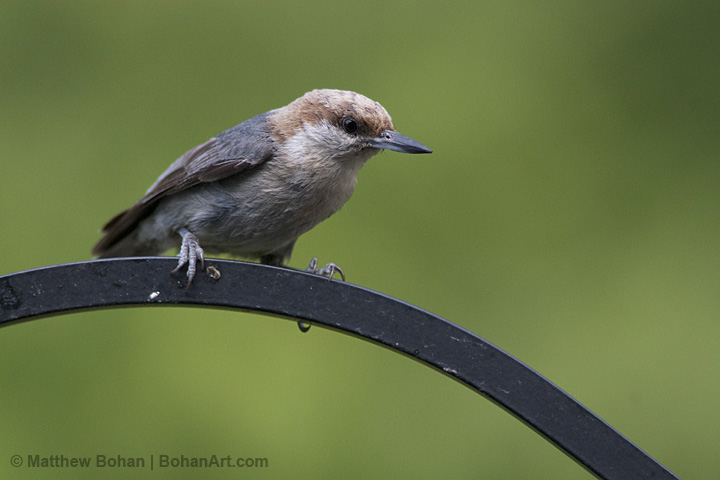
Snowy Egret in Flight Pencil Sketch p37
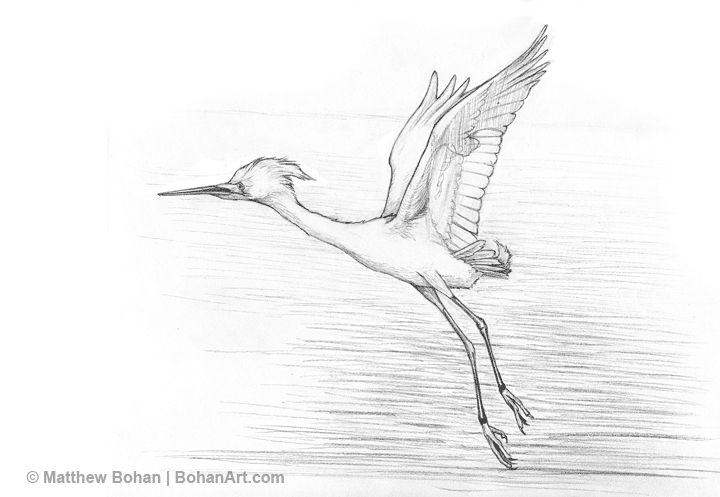
Snowy Egrets seem to have two speeds: full on or full off. At times they are patiently waiting or stalking fish, and then the very next moment they are full of frantic energy.
Growing up in south-western New York, you simply don’t come across Snowy Egrets. I saw my first one in 1988 when I was a grad student helping teach the Ecology of the Everglades. I had seen photos of these guys many times, but seeing them in real life was even better than I anticipated. They are gorgeous little birds with interesting behaviors. Despite their small stature, they can be pretty feisty. I’ve watched a handful of Snowy Egrets successfully mob together and harass White Ibis to steal their food. Typically, however, they are placidly stalking fish at the water’s edge, which is a much more peaceful image.

